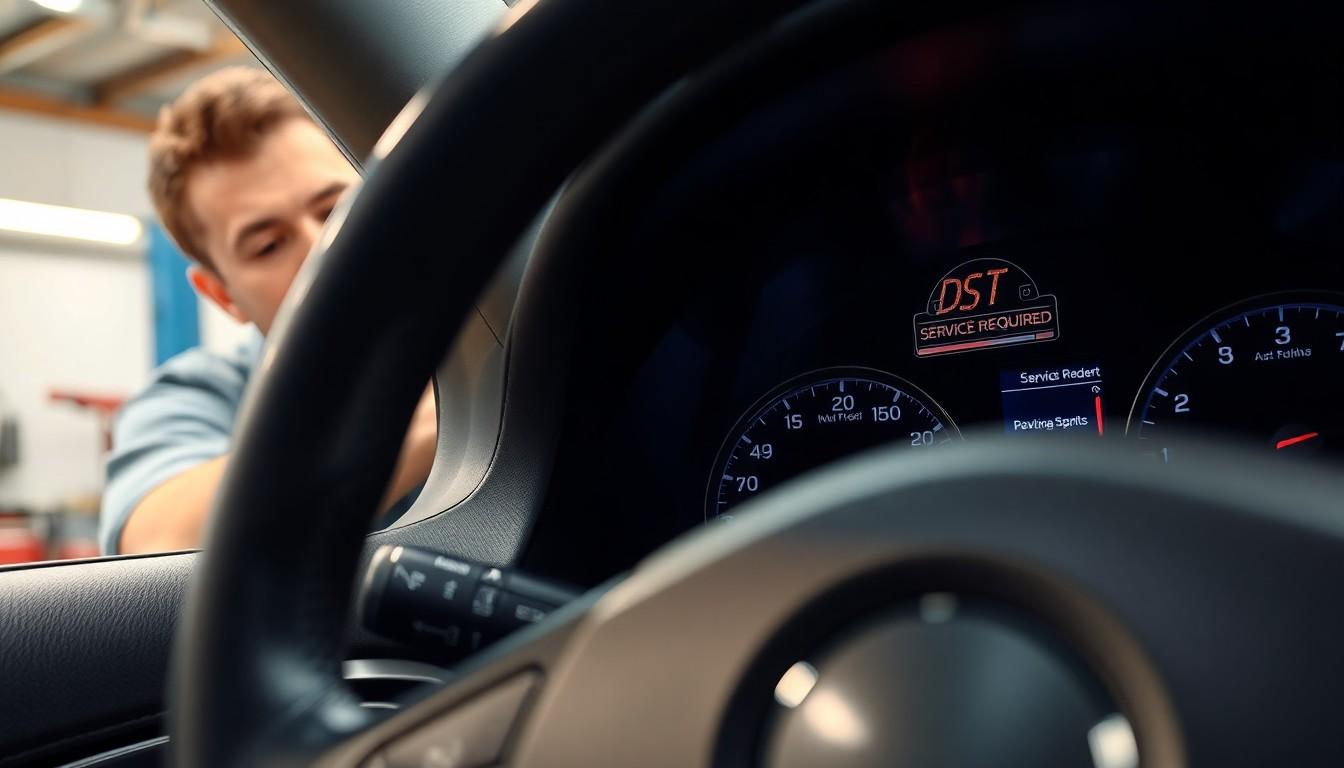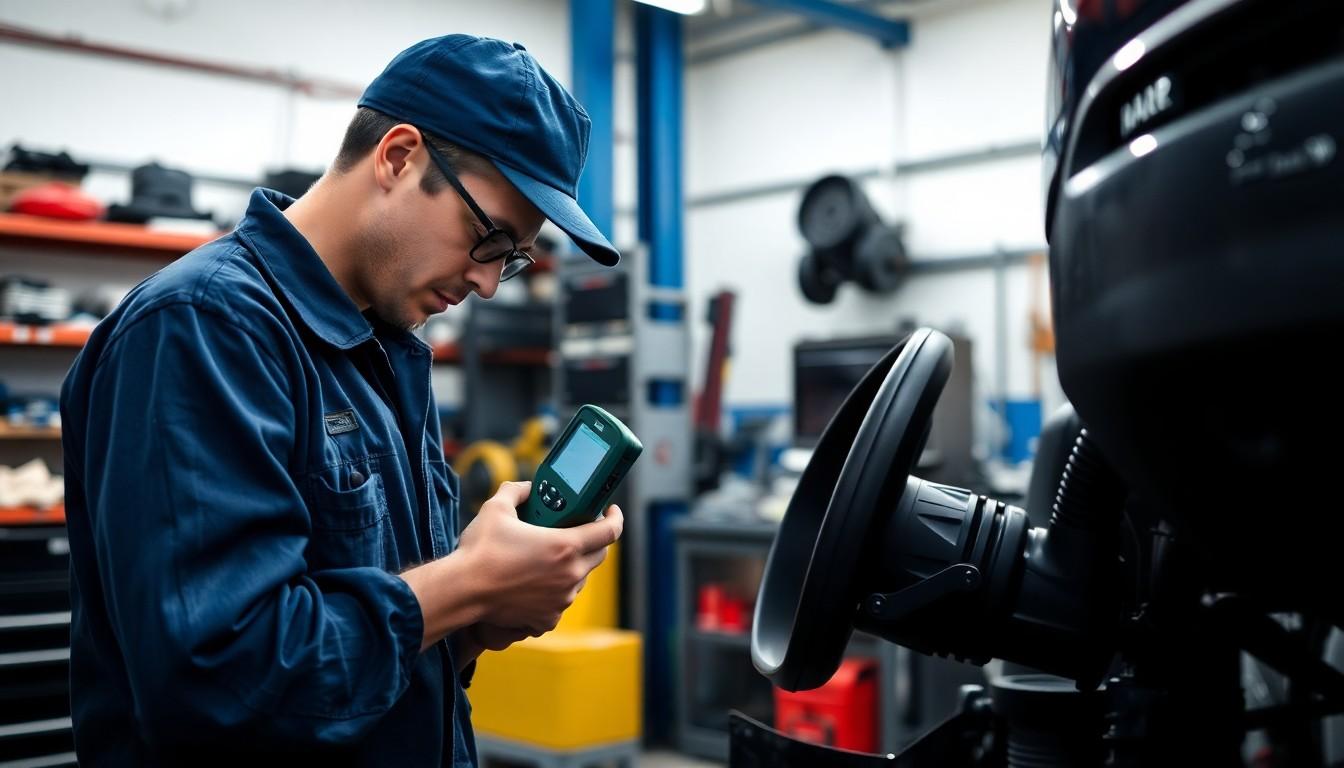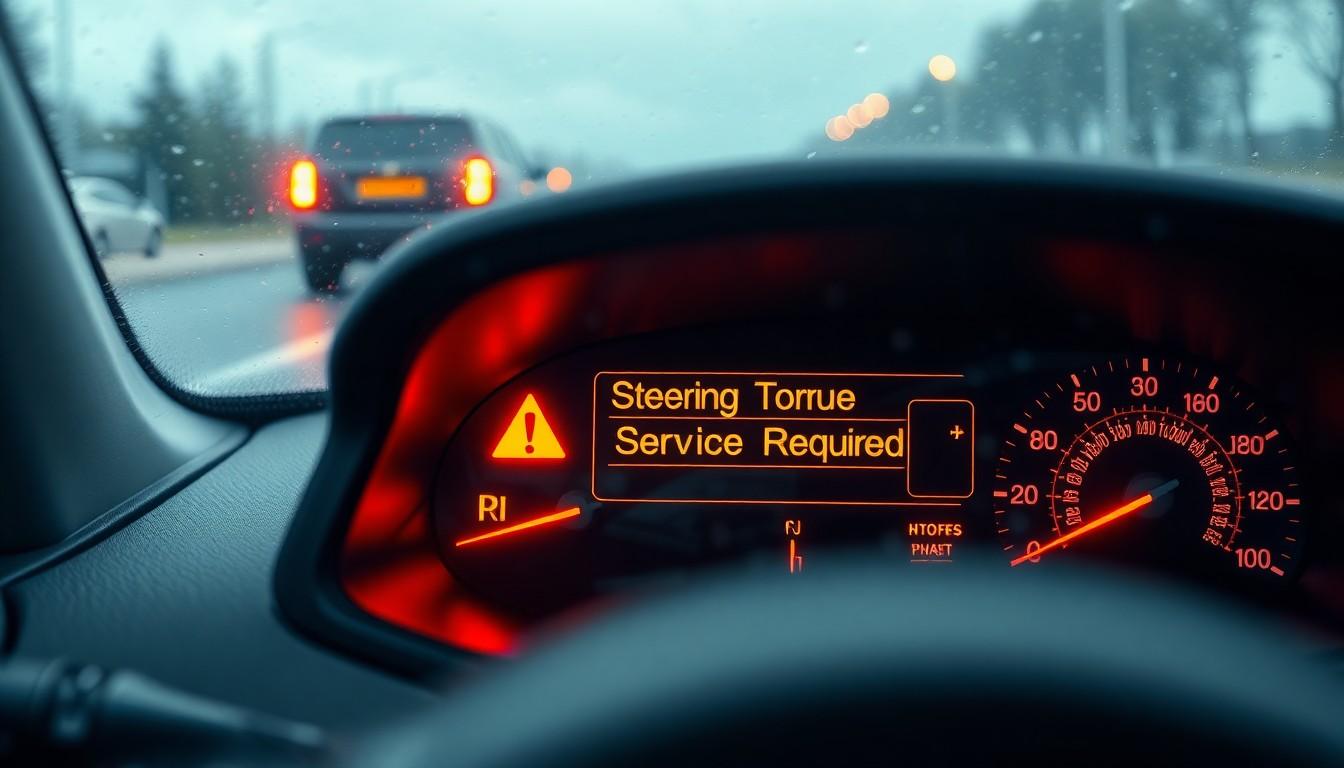When your vehicle displays the “ever-changing steering torque service required” message, it’s not just another dashboard alert to ignore. This warning indicates a potential issue with your car’s advanced steering system that helps maintain stability and control during challenging driving conditions.
We’ve helped thousands of drivers understand and resolve this concerning notification. Left unaddressed, this warning could lead to decreased handling performance, unpredictable steering response, and even safety risks on the road. The good news? Most ever-changing steering torque issues can be fixed quickly when properly diagnosed by qualified technicians.
In this comprehensive guide, we’ll explain what triggers this warning, the risks of ignoring it, and the steps you should take to get your vehicle’s steering system back to optimal performance.
Understanding Dynamic Steering Torque Systems
Ever-changing Steering Torque (DST) systems represent a important advancement in vehicle control technology. These sophisticated systems continuously adjust steering resistance based on driving conditions, improving both safety and driving comfort.
How Ever-changing Steering Technology Works
Ever-changing steering technology operates through a complex integration of electronic and mechanical components. Sensors throughout the vehicle monitor factors like speed, road conditions, and driver input, sending this data to a central control unit. The control unit then calculates the optimal steering resistance and transmits commands to the power steering actuator. This actuator adjusts the steering torque in real-time, providing firmer resistance at high speeds for stability and lighter steering at low speeds for easy maneuverability. The system’s adaptability extends to compensating for crosswinds and road crown effects, automatically counteracting these forces to maintain a straight path without driver intervention.
Common Manufacturers and Models with DST
Audi pioneered ever-changing steering systems with their progressive steering technology found in models like the A4, A6, and Q7. BMW incorporates a similar system called Variable Sport Steering in their 3 Series, 5 Series, and X5 models. Mercedes-Benz features Direct-Steer in C-Class, E-Class, and GLC vehicles, offering varying resistance ratios depending on steering angle. Volvo’s Speed-Dependent Steering in the XC60 and XC90 adjusts steering weight based on vehicle speed. Ford implements Adaptive Steering in their Edge and F-150 models, while General Motors equips select Cadillac models with Variable Effort Steering. These manufacturer-exact systems, though branded differently, share the fundamental goal of optimizing steering response across diverse driving scenarios.
What Does “Dynamic Steering Torque Service Required” Mean?

The “Ever-changing Steering Torque Service Required” warning indicates a problem within your vehicle’s steering system. This sophisticated system doesn’t operate in isolation but works alongside other crucial vehicle components including the Anti-lock Braking System (ABS), power steering mechanisms, and various electronic control modules. Several factors can trigger this warning, ranging from minor software glitches and faulty sensors to more serious mechanical issues like a malfunctioning ABS pump or power steering pump problems.
Warning Signs and Dashboard Indicators
Dashboard indicators provide important clues when a ever-changing steering torque issue arises. The warning message typically appears prominently on your dashboard display, often accompanied by other error messages related to the ABS, Electronic Stability Control (ESC), and electronic parking brake systems. Low voltage in the electrical system sometimes triggers this warning as part of a cluster of messages, potentially preventing your vehicle from starting properly. Many drivers report experiencing multiple error messages simultaneously, which suggests a broader system issue affecting various interconnected components rather than an isolated steering problem.
Severity of the Warning
Understanding the severity level of this warning helps you determine how quickly to address the issue. While not always critical, this warning deserves prompt attention to maintain your vehicle’s safety and optimal performance. Ignoring these alerts risks disrupting essential steering and braking functions, potentially compromising vehicle control. In more severe cases, your vehicle might become difficult to start or even completely unusable until the problem is resolved. Fortunately, many causes behind this warning can be fixed with relatively straightforward and cost-effective answers, such as checking electrical connections, replacing faulty components, or addressing low voltage issues in the vehicle’s battery system.
Common Causes of DST Service Warnings

Ever-changing Steering Torque (DST) service warnings typically appear due to several exact system failures. These warnings indicate problems that require attention to maintain your vehicle’s optimal steering performance and safety features.
Electronic Control Unit Failures
Electronic Control Unit (ECU) issues frequently trigger DST service warnings in modern vehicles. The Anti-lock Braking System (ABS) pump or control module directly interfaces with the ever-changing steering torque system, sending crucial operational signals. Faulty ABS components often transmit incorrect data to the steering system, immediately triggering the “Service Required” message on your dashboard. These electronic failures compromise not only steering performance but also affect related safety systems that depend on accurate communication between vehicle control modules.
Steering Sensor Malfunctions
Steering sensor issues represent another common cause of DST warnings in vehicles equipped with this technology. These sensors continuously monitor steering angle, torque input, and wheel position to provide real-time data to the vehicle’s electronic systems. Any malfunction in these precision instruments disrupts the normal functioning of ever-changing steering torque, creating inconsistent steering feel or resistance. Sensor problems typically develop from electrical connection issues, physical damage, or gradual degradation over time, affecting the system’s ability to accurately adjust steering resistance based on driving conditions.
Hydraulic System Issues
Hydraulic component failures significantly impact DST functionality and can prompt service warnings. The power steering pump serves as the heart of the hydraulic system, generating necessary pressure to assist steering operations. Low fluid levels, pump wear, or pressure line leaks create inconsistent hydraulic pressure that the DST system detects as abnormal. Also, contaminated power steering fluid degrades system components over time, leading to erratic steering assistance and triggering warning messages. Many DST-related hydraulic issues manifest first as unusual noises (whining or groaning) during steering maneuvers before the warning light appears.
Diagnosing Dynamic Steering Torque Problems

Identifying the root cause of ever-changing steering torque issues requires a systematic approach to troubleshooting. Problems triggering the “Ever-changing Steering Torque Service Required” warning often stem from several interconnected components including the ABS system, power steering mechanisms, sensors, and electronic systems.
Common Causes
Ever-changing steering torque warnings typically appear due to exact vehicle malfunctions. Faulty ABS pumps or control modules can disrupt steering functionality since these systems share critical communication networks. Power steering pump failures frequently trigger these warnings through inconsistent steering assistance. Sensor issues send incorrect signals to the steering system, confusing the electronic control unit. Electronic glitches, particularly those related to low voltage conditions, commonly activate multiple dashboard warnings simultaneously. Environmental factors like moisture intrusion into electrical components can also initiate steering system alerts.
Professional Diagnostic Procedures
Professional technicians use specialized equipment and follow comprehensive protocols when diagnosing ever-changing steering torque problems. Mechanics begin by connecting diagnostic scanners to retrieve error codes stored in the vehicle’s computer systems. They perform thorough component inspections of the ABS pump, control modules, power steering pump, and associated sensors to identify visible damage. Electrical system checks verify proper voltage and current throughout the steering and braking subsystems. Functional testing of the ABS and power steering components helps pinpoint exact mechanical or electronic failures that might not be immediately apparent during visual inspection.
DIY Troubleshooting Steps
Several home diagnostic steps can help identify or potentially resolve ever-changing steering torque issues before visiting a repair shop. Start by checking the ABS pump and control module connections for corrosion, looseness, or physical damage. Examine the power steering pump for fluid leaks, unusual noises, or difficulty turning the wheel at low speeds. Inspect sensors around the steering column and wheel wells for secure connections and signs of physical damage. Test your vehicle’s electrical system with a multimeter, focusing on battery voltage which should measure between 12.4-12.7 volts when the engine is off. Try performing a system reset by disconnecting the battery for 30 minutes, which occasionally clears transient electronic faults. Look for moisture accumulation around electronic components, particularly after driving in heavy rain or through flooded areas. Consult your exact vehicle’s manual for model-exact troubleshooting procedures that address known issues with your car’s steering system.
Repair Options and Costs

Addressing a “Ever-changing Steering Torque Service Required” warning involves several repair pathways with varying costs. Let’s explore your options for getting this critical steering system back to optimal performance and what you can expect to pay.
Dealer Service vs. Independent Mechanics
Dealerships provide repairs using original equipment manufacturer (OEM) parts that match exactly what came with your vehicle. These dealer technicians receive specialized training specifically for your vehicle make and model, ensuring thorough familiarity with complex systems like Ever-changing Steering Torque. Their top-notch facilities and diagnostic equipment often detect issues more precisely, though these advantages come with significantly higher labor rates ranging from $75 to $150 per hour.
Independent mechanics offer a more cost-effective alternative while still providing quality repairs. They typically use aftermarket parts that meet industry standards but cost less than OEM components. Many independent shops maintain lower overhead costs, resulting in labor rates between $50 and $100 per hour. When selecting an independent mechanic for DST repairs, verify they have experience with your exact vehicle’s electronic steering systems to ensure proper diagnosis and repair.
Typical Repair Expenses
Repair costs for Ever-changing Steering Torque issues vary widely depending on the underlying cause. Simple fixes like securing loose connections or replacing minor sensors might cost between $100-$500 total. Electronic Control Unit (ECU) reprogramming typically falls in the mid-range of expenses, often costing $300-$700 depending on complexity.
More substantial repairs involving component replacement create higher expenses. ABS pump replacements range from $1,000 to $2,500, while power steering pump replacements typically cost $800 to $2,000. These prices reflect important differences between OEM and aftermarket parts—OEM components generally cost 20-40% more than their aftermarket counterparts.
| Repair Type | Dealer Cost (OEM) | Independent Shop (Aftermarket) |
|---|---|---|
| Connection fixes | $150-$300 | $100-$200 |
| Sensor replacement | $400-$700 | $300-$500 |
| ECU reprogramming | $500-$700 | $300-$500 |
| ABS pump replacement | $1,800-$2,500 | $1,000-$1,800 |
| Power steering pump | $1,500-$2,000 | $800-$1,500 |
Labor costs constitute a important portion of these repairs, especially for components requiring extensive disassembly. Diagnostic fees apply at most repair facilities, though many shops waive this charge if you proceed with their recommended repairs. Some independent mechanics offer payment plans or financing options for higher-cost repairs, making them more manageable for unexpected steering system issues.
Preventive Maintenance Tips

Proactive maintenance significantly reduces the likelihood of seeing the “Ever-changing Steering Torque Service Required” warning on your dashboard. Regular checks and proper care extend your steering system’s lifespan and help avoid costly repairs.
Regular Inspection Recommendations
Routine inspections form the foundation of preventing steering system failures. Check your ABS pump and control module connections every 6-12 months for signs of corrosion or damage. Examine power steering components regularly, looking for fluid leaks or unusual wear patterns that might indicate developing problems. Verify that all sensor connections remain secure and free from moisture damage, as environmental factors often trigger steering system warnings. Monitor your vehicle’s electrical system voltage levels, as low voltage commonly causes multiple error messages including steering torque warnings. These inspections don’t require specialized tools and can easily become part of your regular maintenance routine.
Extending the Life of Your Steering System
Following manufacturer-recommended maintenance schedules dramatically increases steering system longevity. Check and maintain proper power steering fluid levels monthly, replacing fluids according to your vehicle’s service manual specifications. Address any warning messages promptly rather than hoping they’ll resolve themselves, as minor issues can quickly develop into major mechanical failures. Have a qualified mechanic perform repairs when you’re uncomfortable doing them yourself, especially for complex electronic components. Protect your vehicle’s electronic systems from excessive moisture by parking in covered areas during extreme weather conditions. Maintain optimal battery health through regular testing and replacement when necessary, preventing the low voltage issues that commonly affect ever-changing steering torque systems in models like the Jeep Compass and Jeep Renegade. These preventive measures typically cost under $100 annually but can save thousands in potential repair costs.
Safety Considerations When Driving with DST Issues

Ever-changing Steering Torque system issues can significantly compromise your vehicle’s safety and handling capabilities. When your dashboard displays the “Ever-changing Steering Torque Service Required” warning, understanding the potential risks and appropriate responses is crucial for maintaining control of your vehicle.
Impact on Vehicle Stability
Ever-changing Steering Torque problems directly affect your vehicle’s stability, particularly during critical maneuvers like emergency braking or sudden steering corrections. The system’s integration with the Anti-lock Braking System (ABS) means that malfunctions can disrupt multiple safety features simultaneously.
A compromised ABS pump or control module throws off your vehicle’s balance, making it noticeably harder to control in challenging situations. This reduced stability becomes particularly dangerous on wet roads, during high-speed driving, or when handling sharp turns.
Potential Risks
Continuing to drive with DST issues substantially increases accident risk, especially during adverse weather conditions like rain or snow. Your vehicle’s Electronic Stability Control (ESC) and Hill Holder functions may also become compromised as these systems share electronic components with the Ever-changing Steering Torque system.
The steering response might become unpredictable, with inconsistent resistance that makes precise handling difficult. This unpredictability creates dangerous situations where you might over-correct or under-correct when steering, potentially leading to loss of control.
When to Stop Driving Immediately
Multiple simultaneous error messages demand immediate attention. If your dashboard displays combinations of warnings such as “Service ESC System,” “Service Hill Holder,” and “Service Transmission” alongside the DST warning, pull over safely as soon as possible. These clustered warnings indicate widespread electronic system failures that make continued driving hazardous.
Steering wheel misalignment presents another critical situation requiring immediate action. A steering wheel that’s turned 90 degrees from its normal position or feels unusually difficult to control signals severe DST system failure. Continuing to drive with such symptoms dramatically increases accident risk.
Electrical system issues, particularly low voltage, often trigger DST warnings and can prevent your vehicle from starting if left unaddressed. If your electrical system shows signs of malfunction alongside the DST warning, stopping and addressing the issue prevents being stranded in potentially dangerous locations.
Temporary Workarounds
Checking your electrical system components provides a good starting point for troubleshooting. Low voltage commonly triggers multiple error messages, including the DST warning. Inspect your battery connections for corrosion or looseness and ensure your alternator is functioning properly.
A quick inspection of ABS and power steering components might reveal obvious issues. Look for fluid leaks around the power steering pump, damaged wiring connections to the ABS module, or loose electrical connectors. Securing any disconnected components sometimes resolves temporary DST warnings.
Driving technique adjustments can help manage the vehicle until proper repairs are completed. Reduce your speed, avoid sharp steering inputs, and maintain greater following distances to compensate for potentially compromised handling characteristics. Gentle acceleration and braking minimize strain on affected systems.
Remember that these workarounds only serve as temporary measures. Professional diagnosis and repair remain essential for restoring your vehicle’s safety systems to proper working condition and ensuring your continued safety on the road.
Conclusion
The “Ever-changing Steering Torque Service Required” warning shouldn’t be ignored or taken lightly. It’s a critical indicator that your vehicle’s sophisticated steering system needs attention. While the potential causes range from minor electrical issues to more serious mechanical problems the answers are typically straightforward when addressed promptly.
We recommend taking immediate action when this warning appears to ensure your safety and maintain optimal vehicle performance. Regular preventive maintenance can help you avoid these issues altogether saving you time and money in the long run.
Remember that your vehicle’s steering system is essential for control and stability especially in challenging driving conditions. Investing in proper diagnosis and repair will protect both your investment and everyone’s safety on the road.
Frequently Asked Questions
What is the “Ever-Changing Steering Torque Service Required” warning?
This warning indicates a potential issue with your vehicle’s Dynamic Steering Torque (DST) system, which continuously adjusts steering resistance based on driving conditions. It could stem from problems with the electronic control unit, steering sensors, or hydraulic components. This warning should not be ignored as it affects your vehicle’s handling, stability, and safety, especially in challenging driving conditions.
Is it safe to drive with this warning light on?
It’s not recommended to drive with this warning active. The DST system is crucial for vehicle stability, especially during emergency maneuvers or in adverse weather. Continuing to drive could compromise your ability to control the vehicle, increasing accident risk. If the warning appears with multiple error messages or if your steering feels unusual, safely pull over and arrange for professional assistance.
What causes the DST service warning?
Common causes include ECU failures (often linked to ABS components), steering sensor malfunctions (from electrical issues or physical damage), and hydraulic system problems (like low fluid levels or pump wear). The warning can also be triggered by software glitches, electrical connection issues, or integration problems with other vehicle systems such as the ABS or electronic stability control.
How much does it cost to fix this issue?
Repair costs vary widely depending on the underlying cause. Simple fixes like electrical connections or software updates range from $100-$500. More substantial repairs, such as replacing an ABS pump or power steering component, can cost between $800-$2,500. Dealership repairs tend to be more expensive than independent mechanics, though they offer manufacturer-specific expertise and original parts.
Can I troubleshoot this warning myself?
Yes, you can perform some basic troubleshooting before seeking professional help. Check electrical connections for corrosion or damage, inspect the power steering system for fluid leaks, test the battery and alternator, and try resetting the vehicle’s computer system (by disconnecting the battery for 15 minutes). However, for accurate diagnosis, specialized diagnostic equipment is usually required.
Which car models commonly experience DST issues?
DST systems are found in many modern vehicles from manufacturers including Audi, BMW, Mercedes-Benz, Volvo, Ford, and General Motors. While different brands may use various names for their systems, they all serve similar functions. Higher-end models with advanced driver assistance features are more likely to have these sophisticated steering systems and potentially experience related warnings.
How can I prevent DST issues?
Regular maintenance is key to prevention. Inspect the ABS pump, power steering components, and sensor connections every 6-12 months. Maintain proper power steering fluid levels and quality. Address minor warning messages promptly before they escalate. Keep electronic systems protected from moisture and extreme temperatures. These preventive measures typically cost under $100 annually but can save thousands in repairs.
Will the warning reset itself after fixing the issue?
In most cases, the warning needs to be reset using a diagnostic scanner after repairs are completed. While some minor issues might temporarily resolve themselves (like intermittent electrical connections), properly fixing the underlying problem and clearing the error codes is essential for ensuring the system functions correctly. Most repair facilities will include this reset as part of their service.

